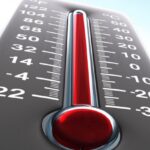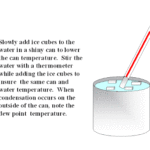The instruments used to measure humidity are called hygrometers. The simplest form of hygrometer is called a psychrometer. It consists of two thermometers mounted on the same frame that can be whirled in the air by hand. This is described in detail in the wet bulb temperature.
The wet- and dry-bulb temperatures together determine the state point of the air on the psychrometric chart, allowing all other variables to be determined. In air that has less than 100 per cent relative humidity, the wet bulb will record a lower temperature than the dry bulb. This difference in temperature is known as wet-bulb depression. A special chart is used to convert the wet bulb depression to relative humidity.
The relationship between dry-bulb, wet-bulb and RH is tabulated below:

Higher the differential between the dry bulb and wet bulb temperature, lower shall be the relative humidity. A 10°F differential represents the Relative humidity of 55%.
• If the wet bulb temperature is lower than dry bulb the air-vapor mixture is unsaturated
• If the wet bulb temperature is the same as the dry bulb the air vapor is saturated
Other humidity measurement devices include an electric sensing element or a mechanical system.
The mechanical hygrometer uses a single human hair as a sensing element. The hair is attached to a spring and a dial. When the relative humidity increases, the cells in the hair swell and contract, pulling the spring and the dial hand. At a lower relative humidity, the hair cells relax and it lengthens, releasing the tension on the spring and allowing the dial hand to move in the opposite direction. The response to changes in relative humidity is slow and is not dependable at very high relative humidity. These devices are acceptable as an indicator of a general range of humidity but are not suitable for accurate measurements.
A more accurate measurement is achieved with an electronic hygrometer. It measures the change in the electrical resistance of a thin layer of lithium chloride, or of a semiconductor device, as the relative humidity changes. Other hygrometers sense changes in weight, volume, or the transparency of various substances that respond to relative humidity.


